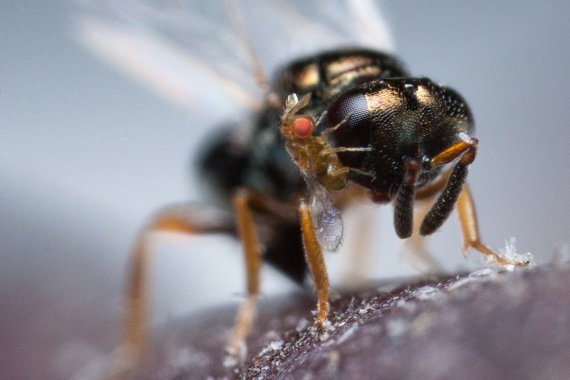© Jitte Groothuis. A Trichogramma evanescens sitting on the eye of the larger parasitic wasp Nasonia vitripennis.
Van der Woude’s study builds on a remarkable discovery she made when working on her Master’s thesis. Measurements of parasitic wasps then showed that these creatures do not abide by Haller’s law, which states a relation in size between the brain and the body of an organism: the smaller the animal, the larger the brain in relative terms. The relation is exponential. But in the parasitic wasp Trichogramma evanescens the relation between body and brain size is linear, discovered Van der Woude. A parasitic wasp that is twice as small as another one has a brain twice as small too. Smaller than is theoretically possible. This makes sense in terms of energy, a lot of which is needed to maintain a brain. In her PhD research, Van der Woude delved deeper into this mystery.
At 0.3 to 0.9 millimetres in size, Trichogrammas are amongst the smallest creatures on earth. Their brains are 50 to 100 micrometres in size, and working on them is microsurgery. Van der Woude: ‘You work under a microscope with sharp tweezers.’ Her ‘victims’ came from a genetically identical line of sister wasps, bred so that their measurements would vary.
The most likely explanation for the relatively small brain volume of tiny parasitic wasps is that they have fewer brain cells. Van der Woude investigated that by studying the olfactory system in the brain, which processes odours. She found that wasps of different sizes possess the same number of glomeruli, spherical structures for odour processing. It also turned out that larger and smaller wasps have the same quantities of the neurons which express neurotransmitters such as serotonin and dopamine. These neurons are smaller in small wasps, however.
So parasitic wasps seem to be in command of a trick with which they can adapt the size of their brain cells to their environment. And that does not happen at the expense of their ability to learn, showed tests in which wasps were taught to remember odours or colours. Larger and smaller wasps learn equally fast, and remember what they have learned equally long. This is what Van der Woude calls the art of the parasitic wasp: ‘Making brains smaller than you would expect according to Haller’s law, without any loss to the complexity and learning capacity of the brain.’
But of course, this trick has its price. Smaller parasitic wasps have shorter lifespans, as was discovered back in the 1980s. Van der Woude assumes that the smaller cells of tiny Trichogrammas are less equipped to keep up with internal maintenance.


